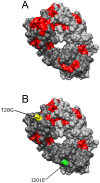A consensus method for the prediction of 'aggregation-prone' peptides in globular proteins
- PMID: 23326595
- PMCID: PMC3542318
- DOI: 10.1371/journal.pone.0054175
A consensus method for the prediction of 'aggregation-prone' peptides in globular proteins
Abstract
The purpose of this work was to construct a consensus prediction algorithm of 'aggregation-prone' peptides in globular proteins, combining existing tools. This allows comparison of the different algorithms and the production of more objective and accurate results. Eleven (11) individual methods are combined and produce AMYLPRED2, a publicly, freely available web tool to academic users (http://biophysics.biol.uoa.gr/AMYLPRED2), for the consensus prediction of amyloidogenic determinants/'aggregation-prone' peptides in proteins, from sequence alone. The performance of AMYLPRED2 indicates that it functions better than individual aggregation-prediction algorithms, as perhaps expected. AMYLPRED2 is a useful tool for identifying amyloid-forming regions in proteins that are associated with several conformational diseases, called amyloidoses, such as Altzheimer's, Parkinson's, prion diseases and type II diabetes. It may also be useful for understanding the properties of protein folding and misfolding and for helping to the control of protein aggregation/solubility in biotechnology (recombinant proteins forming bacterial inclusion bodies) and biotherapeutics (monoclonal antibodies and biopharmaceutical proteins).
Conflict of interest statement
Figures

Similar articles
-
Amyloidogenic determinants are usually not buried.BMC Struct Biol. 2009 Jul 9;9:44. doi: 10.1186/1472-6807-9-44. BMC Struct Biol. 2009. PMID: 19589171 Free PMC article.
-
CPAD, Curated Protein Aggregation Database: A Repository of Manually Curated Experimental Data on Protein and Peptide Aggregation.PLoS One. 2016 Apr 4;11(4):e0152949. doi: 10.1371/journal.pone.0152949. eCollection 2016. PLoS One. 2016. PMID: 27043825 Free PMC article.
-
Fundamentals of cross-seeding of amyloid proteins: an introduction.J Mater Chem B. 2019 Dec 14;7(46):7267-7282. doi: 10.1039/c9tb01871a. Epub 2019 Oct 24. J Mater Chem B. 2019. PMID: 31647489 Review.
-
Misfolding of amyloidogenic proteins and their interactions with membranes.Biomolecules. 2013 Dec 27;4(1):20-55. doi: 10.3390/biom4010020. Biomolecules. 2013. PMID: 24970204 Free PMC article. Review.
-
Intrinsic aggregation propensity of the CsgB nucleator protein is crucial for curli fiber formation.J Struct Biol. 2016 Aug;195(2):179-189. doi: 10.1016/j.jsb.2016.05.012. Epub 2016 May 28. J Struct Biol. 2016. PMID: 27245712
Cited by
-
Comparison of the pH- and thermally-induced fluctuations of a therapeutic antibody Fab fragment by molecular dynamics simulation.Comput Struct Biotechnol J. 2021 May 4;19:2726-2741. doi: 10.1016/j.csbj.2021.05.005. eCollection 2021. Comput Struct Biotechnol J. 2021. PMID: 34093988 Free PMC article.
-
Stability of Protein Pharmaceuticals: Recent Advances.Pharm Res. 2024 Jul;41(7):1301-1367. doi: 10.1007/s11095-024-03726-x. Epub 2024 Jun 27. Pharm Res. 2024. PMID: 38937372 Review.
-
Assembly and disassembly of Aspergillus fumigatus conidial rodlets.Cell Surf. 2019 Mar 6;5:100023. doi: 10.1016/j.tcsw.2019.100023. eCollection 2019 Dec. Cell Surf. 2019. PMID: 32743139 Free PMC article.
-
Mechanisms for the inhibition of amyloid aggregation by small ligands.Biosci Rep. 2016 Sep 29;36(5):e00385. doi: 10.1042/BSR20160101. Print 2016 Oct. Biosci Rep. 2016. PMID: 27512096 Free PMC article.
-
Proteome-scale understanding of relationship between homo-repeat enrichments and protein aggregation properties.PLoS One. 2018 Nov 6;13(11):e0206941. doi: 10.1371/journal.pone.0206941. eCollection 2018. PLoS One. 2018. PMID: 30399196 Free PMC article.
References
-
- Fink AL (1998) Protein aggregation: folding aggregates, inclusion bodies and amyloid. Fold Des 3: R9–23. - PubMed
-
- Harrison RS, Sharpe PC, Singh Y, Fairlie DP (2007) Amyloid peptides and proteins in review. Rev Physiol Biochem Pharmacol 159: 1–77. - PubMed
-
- Chiti F, Dobson CM (2009) Amyloid formation by globular proteins under native conditions. Nat Chem Biol 5: 15–22. - PubMed
-
- Iconomidou VA, Vriend G, Hamodrakas SJ (2000) Amyloids protect the silkmoth oocyte and embryo. FEBS Lett 479: 141–145. - PubMed
Publication types
MeSH terms
Substances
LinkOut - more resources
Full Text Sources
Other Literature Sources
Molecular Biology Databases

